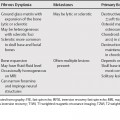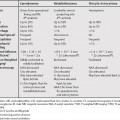103 Epiploic appendices are small adipose protrusions from the serosal surface of the colon. The appendices can undergo torsion with resulting ischemia/infarction. Epiploic appendagitis can occur anywhere there is an epiploic appendage, but the majority (53%) of cases are in the sigmoid colon region. Epiploic appendagitis can mimic diverticulitis or appendicitis clinically, but can be differentiated from appendicitis and diverticulitis on computed tomography (CT), with characteristic findings of a 1- to 4-cm fat attenuation mass (often with a hyperattenuating rim), periappendiceal fat stranding, and thickened visceral peritoneal lining. A central area (“central dot”) of high attenuation can be seen in slightly more than half of cases, possibly secondary to a thrombosed vein.1
Epiploic Appendagitis versus Omental Infarction
![]()
Stay updated, free articles. Join our Telegram channel

Full access? Get Clinical Tree





